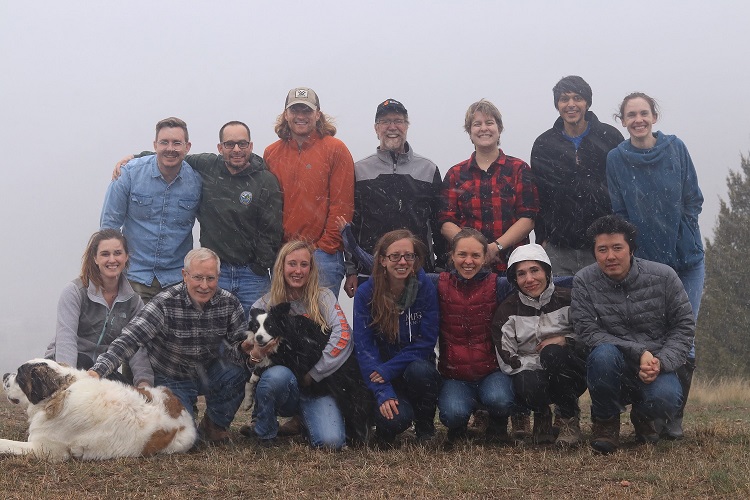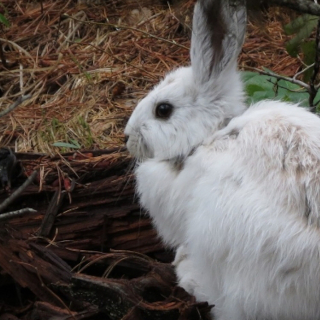Reflections from Scott on our 2019 graduates, and new students

September 2019
This past spring I had THREE graduate students defend their theses and fledge the nest: a momentous, thrilling, ecstatically happy and dismally bittersweet time. Of course the mixed emotions arose from their accomplishments and the occasion: these fine folks -- who have been part of my life, my families’ life, supporting each other and thinking big thoughts and doing great things – they jumped through the big hoop that brought them here, and now they are gone, off to their next accomplishment.
I’ll embarrass them with intros, each in order of when they came into our lives:
Marketa Zimova arrived from Czech Republic as a non-degree graduate student. She took my applied wildlife population ecology course, and eventually asked if she could get some research experience by volunteering on my projects. She was a big-city gal (Prague), had no field experience, had never driven a big Ford F-250 (aka my research truck), knew nothing about telemetry. Her English was good but had some gaps in understanding American puns (a fact mercilessly exploited by my hilarious field crew at the time). But she has an amazing can-do attitude, an unrelenting smile, and a fierce creativity and smarts. I had just started the snowshoe hare coat color mismatch study, and after Marketa wrecked my research snowmobile (!!) I offered her a MS position (“Camouflage mismatch in seasonal coat color due to decreased snow duration: will snowshoe hares keep up with climate change?”). She finished her MS soon after I moved to NCSU in 2013, and started a PhD with me back there, still on the topic of camouflage mismatch and climate change (Dissertation title: "Evolutionary ecology of color molt phenology and camouflage mismatch"). She returned with me back to University of Montana in 2016. Now many great years and laughs and manuscripts together (you can find Marketa’s publications, most of which are cover articles, on this website), we are proud of her as she heads off to a Post Doc at University of Michigan.
Brandon Davis caught my attention when he was a Univ MT undergraduate around 2011. He was, like me, a North Carolina native, a kindred spirit in barbeque and fried okra, but when I threw him into our snowshoe hare projects I learned that he could also hold his own in the wilds of Montana. Before long he was working on a senior thesis project on behavioral plasticity in snowshoe hares, testing whether color mismatched hares responded to an approaching dog the same way that they responded to approaching people. His research companion became my golden lab, whose red hair was a perfect match to Brandon’s. When I moved to NCSU in 2013, I hired Brandon to run a new project with snowshoe hares in the rugged, rural Monongahela National Forest of West Virginia. He was a perfect fit for the snow and the steepness, and in making the human connections so critical when starting a new project in a new place (everyone Brandon meets becomes his friend, basking in the glow of his enthusiasm and humor). When I returned to UM in 2016, Brandon started a MS studying seasonal coat color in weasels. He figured out how to capture them on remote cameras, and invented the (in)famous ‘waltzing weasel’ as he broke new ground with his thesis “Weasely Recognized or Stoatally Camouflaged: Quantifying Coat Color of a Cryptic Predator".
Tashi Dhendup, from Bhutan, received a World Wildlife Fund “Russell Train Fellowship” and began his MS with me in 2016 ("Tiger monitoring in Bhutan using non-invasive genetic tools"). Tashi follows in the footsteps of a number of very special Bhutanese students who have done graduate work here at University of Montana. Before Tashi joined us he had received grants and awards from international non-profits and governments, and co authored over a dozen publications and technical reports. And even as Tashi mastered DNA extraction and microsatellite scoring and spatially explicit capture-recapture techniques for his thesis here at UM, he was recognized on a big stage as a National Geographic Young Explorer. Tashi is a keen and prolific champion of outreaching his scientific results to the public through Facebook groups, the National Geographic Blog, the IUCN website, the media and other forums. Now, Tashi is an Officer at the Ugyen Wangchuck Institute for Conservation and Environmental Research, which means he is one of a handful of professors who teach natural resource theory, concepts, and hands on techniques to professionals who work to implement conservation activities in Bhutan. Also, Tashi will be setting up Bhutan’s very first noninvasive wildlife genetics lab! Go Tashi!
I could go on and on about these folks, but suffice it to say that our lives, and conservation science, are much richer from their time here. And now we have welcomed a new batch of graduate students (welcome PhD student Hannah Walker from southern CA, and MS student Lindsey Barnard, who by the way this spring successfully defended her undergraduate Honor’s Thesis on snowshoe hare behavior)! We also have a new undergraduate student, Katrina Theisen, who will be doing her honors thesis with the lab. More info on our new students can be found on our People page. The proud tradition continues …
Feature Image: The Mills Lab (and friends) at our 2019 lab retreat (Image credit Tashi Dhendup)
